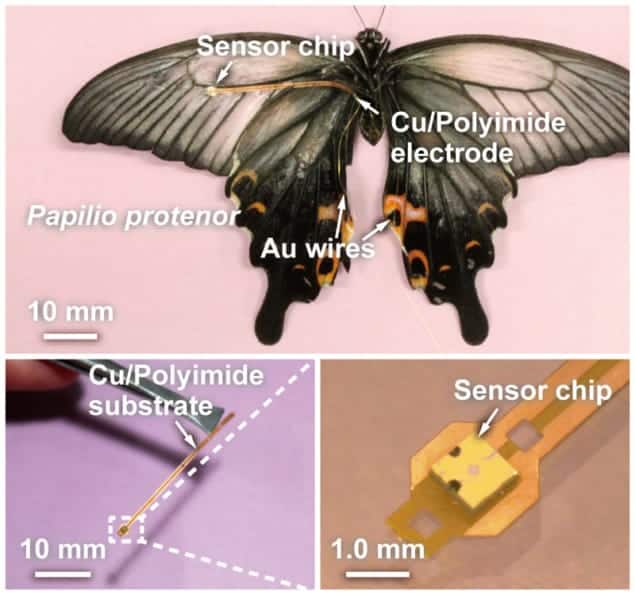
Researchers in Japan have built a tiny sensor that can measure the pressure differences on a butterfly’s wing, helping to better understand the dynamics of insect flight. The team hopes to study the different pressures acting on the wing during take-off, something that has never been measured before. The work will help in building robotic insect-sized flyers or to develop artificial wings.
The seemingly impossible manoeuvres that insects can perform during flight – such as hovering and sudden turns that are very difficult for birds – have long interested researchers. Among the many winged insects, butterflies, and more specifically the Papilionidae family of butterflies (commonly known as swallowtail butterflies) possess a unique wing design that allows them to ascend in a zigzagging path, with low flapping frequency. Hidetoshi Takahashi from Tokyo University, who is lead author and part of the team conducting the research, points out that, according to conventional aerodynamics, the estimated force generated by a flapping insect wing should be insufficient to support its body weight. This means that the actual aerodynamic force of an insect wing exceeds that observed under steady aerodynamics, – where there are equally distributed forces acting across a surface – making it more likely that some “unsteady aerodynamic phenomena” come into play. That is why many researchers have been trying to reveal the mechanism behind this unsteady force, explains Takahashi.
Unsteady aerodynamics
To find out more about these unsteady phenomena, the team has tried to measure the differential pressure distribution – responsible for the aerodynamic force – across an insect’s wing. The work had two main aims – first, to develop a microelectromechanical system (MEMS) differential-pressure sensor that is light enough to let the butterfly achieve flight and that also has high sensitivity to detect minute pressure differences. The second was to measure the force on the wing, mainly during take-off, as the actual aerodynamic force generated by real insect wings during free flight has never been measured directly. “Previous research has been limited to large-scale, tethered conditions using robotic flappers. This makes it difficult to duplicate the actual interaction of the aerodynamic forces with the body motion and wing deformation of insects,” explains Takahashi.
Tiny sensor
The researchers built a piezoresistive cantilever, measuring 125 µm × 100 µm × 0.3 µm. The differential pressure between the upper and lower surfaces of the cantilever causes it to bend and this deformation, in turn, registers as a resistance change in the sensor. “The resolution of the differential pressure is 0.02 Pa from –20 Pa to 20 Pa. Also, the structure is very simple so that the sensor chip can be subminiaturized easily” says Takahashi.
The sensor was then attached to a butterfly wing and the output was measured through a copper-polyimide electrode and gold wires. The total weight of the attachment, including the sensor chip, electrode and wires is 35 mg – lighter than the amount of food that the butterfly consumes at a given time, which is about 100 mg.
“We measured the differential-pressure distribution of four points on the wings of eight butterflies during take-off. “Our measurements show that the differential pressure simply rises and falls periodically and symmetrically in accordance with wing motion. The magnitude of the differential pressure increases as the position shifts from the wing root to the tip during take-off,” explains Takahashi. The researchers also found the instantaneous pressure at the forewing tip reaches a maximum of 10 Pa, which is 10 times larger than the wing loading of the butterfly.
The team points out that understanding the varying aerodynamic forces acting on flying insects using this direct measurement method could help in developing artificial insect-sized flyers in the future. Such robotic insects could be built specifically to easily get into restricted or dangerous spaces, such as disaster sites, to help assess the situation. Also, the studies could help in building artificial wings for aerodynamic experiments or real-time flight control.
The work is reported in Bioinspir. Biomim. 7 036020.



